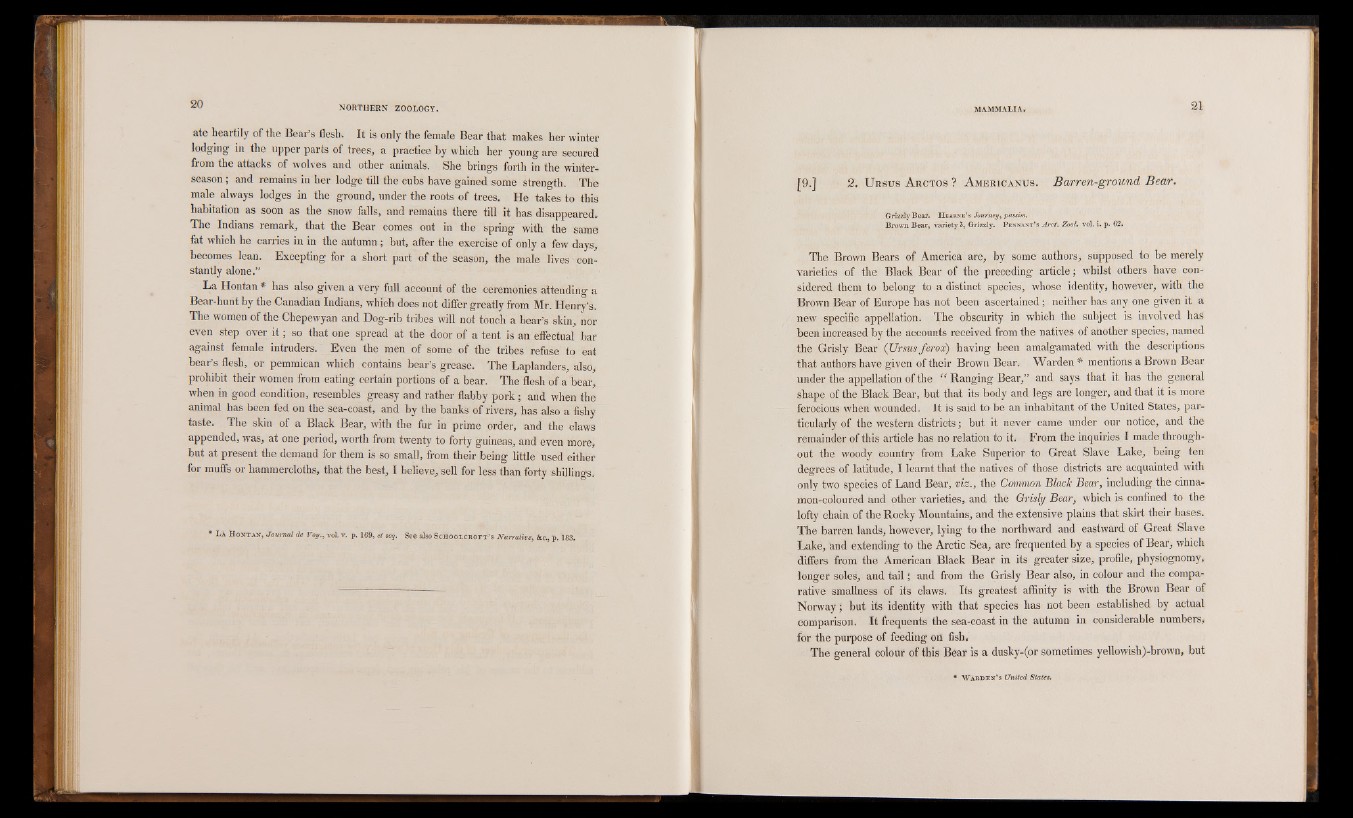
ate heartily of the Bear’s flesh. It is only the female Bear that makes her winter
lodging in the upper parts of trees, a practice by which her young are secured
from the attacks of wolves and other animals. She brings forth in the winter-
season ; and remains in her lodge till the cubs have gained some strength. The
male always lodges in the ground, under the roots of trees. He takes to this
habitation as soon as the snow falls, and remains there till it has disappeared.
The Indians remark, that the Bear comes out in the spring with the same
fat which he carries in in the autumn; but, after the exercise of only a few days,
becomes lean. Excepting for a short part of the season, the male lives constantly
alone.”
La Hontan * has also given a very full account of the ceremonies attending a
Bear-hunt by the Canadian Indians, which does not differ greatly from Mr. Henry’s.
The women of the Chepewyan and Dog-rib tribes will not touch a bear’s skin, nor
even step over i t ; so that one spread at the door of a tent is an effectual bar
against female intruders. Even the men of some of the tribes refuse to eat
bear’s flesh, or pemmican which contains bear’s grease. The Laplanders, also,
prohibit their women from eating certain portions of a bear. The flesh of a bear,
when in good condition, resembles greasy and rather flabby pork; and when the
animal has been fed on the sea-coast, and by the banks of rivers, has also a fishy
taste. The skin of a Black Bear, with the fur in prime order, and the claws
appended, was, at one period, worth from twenty to forty guineas, and even more,
but at present the demand for them is so small, from their being little Used either
for muffs or hammercloths, that the best, I believe, sell for less than forty shillings.
* LA Hontan, Journal de V o y vol. v. p. 16'9, et seq. See also Schoolcroft’s Narrative, &c., p. 183.
[9.] 2. U rsus A rctos ? A mericanus. Barren-ground Bear.
Grizzly Bear. H earne* s Journey, passim.
Brown Bear, variety 2, Grizzly. P ennant’s Arct. Zoo/, vol. i. p. 62.
The Brown Bears of America are, by some authors, supposed to be merely
varieties of the Black Bear of the preceding article; whilst others have considered
them to belong to a distinct species, whose identity, however, with the
Brown Bear of Europe has not been ascertained; neither has any one given it a
new specific appellation. The obscurity in which the subject is involved has'
been increased by the accounts received from the natives of another species, named
the Grisly Bear (Ursus ferox) having been amalgamated with the descriptions
that authors have given of their Brown Bear, Warden * mentions a Brown Bear
under the appellation of the “ Ranging Bear,” and says that it has the general
shape of the Black Bear, but that its body and legs are longer, and that it is more
ferocious when wounded. It is said to be an inhabitant of the United States, particularly
of the western districts; but it never came under our notice, and the
remainder of this article has no relatiou to it, From the inquiries I made throughout
the woody country from Lake Superior to Great Slave Lake, being ten
degrees of latitude, I learnt that the natives of those districts are acquainted with
only two species of Land Bear, vis., the Common Black Bear, including the cinnamon
coloured and other varieties, and the Grisly Bear, which is confined to the
lofty chain of the Rocky Mountains, and the extensive plains that skirt their bases.
The barren lands, however, lying to the northward and eastward of Great Slave
Lake, and extending to the Arctic Sea, are frequented by a species of Bear, which
differs from the American Black Bear in its greater size, profile, physiognomy,
longer soles, and tail; and from the Grisly Bear also, in colour and the comparative
smallness of its claws, Its greatest affinity is with the Brown Bear of
Norway; but its identity with that species has not been established by actual
comparison. It frequents the sea-coast in the autumn in considerable numbers,
for the purpose of feeding oil fish,
The general colour of this Bear is a dusky-(or sometimes yellowish)-brown, but
* Warden’s United States.